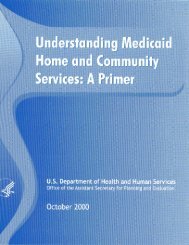STRATEGIC PLAN - ASPE - U.S. Department of Health and Human ...
STRATEGIC PLAN - ASPE - U.S. Department of Health and Human ...
STRATEGIC PLAN - ASPE - U.S. Department of Health and Human ...
You also want an ePaper? Increase the reach of your titles
YUMPU automatically turns print PDFs into web optimized ePapers that Google loves.
CHAPTER 2: <strong>Health</strong> careClearly, health IT is the critical tool that can significantlyreduce medical error, engage consumers <strong>and</strong> patients intheir own health <strong>and</strong> care, <strong>and</strong> provide information in acoordinated fashion. In addition, public health <strong>and</strong>bioterrorism surveillance can be seamlessly integratedinto care, <strong>and</strong> clinical research will be accelerated <strong>and</strong>postmarketing surveillance exp<strong>and</strong>ed. Interoperablehealth IT is the key to transforming our health care system.Advancing the Development <strong>and</strong> Use<strong>of</strong> <strong>Health</strong> Information Technology<strong>Health</strong> information technology isdefined as systems <strong>and</strong> productsthat electronically create, store,transmit, <strong>and</strong> present personal healthinformation for multiple purposes,most notably for patient care.The Institute <strong>of</strong> Medicine estimates that 44,000 to98,000 Americans die each year from medical errors.Many more die or have permanent disability because<strong>of</strong> inappropriate treatments, mistreatments, or missedtreatments in ambulatory settings. Predictive modelshave projected that as much as $300 billion is spenteach year on health care that is the result <strong>of</strong> ourfragmented, uninformed, <strong>and</strong> uncoordinated healthcare system. According to the National Coalition on<strong>Health</strong> Care, in 2004 health care spending in the UnitedStates reached $1.9 trillion <strong>and</strong> was projected to reach$2.9 trillion in 2009, if the current system does notchange. In order for health care in the United States tobe safe, timely, effective, efficient, equitable, <strong>and</strong> patientcentered, three elements will be necessary:• All relevant information (about a patient, the latestscientific evidence, <strong>and</strong> environmental factors)must be available electronically at the time <strong>of</strong>patient care;• Patients must be informed <strong>and</strong> engaged in theirown health; <strong>and</strong>• Care must be considered, assessed, <strong>and</strong> coordinatedacross multiple sites <strong>and</strong> settings.Office <strong>of</strong> the National CoordinatorThe Office <strong>of</strong> the National Coordinator for <strong>Health</strong>Information Technology (ONC) provides leadershipfor the development <strong>and</strong> nationwide implementation<strong>of</strong> interoperable health information technology, whichhas the potential to lower costs, reduce medical errors,improve the quality <strong>of</strong> care, <strong>and</strong> provide patients <strong>and</strong>physicians with new ways to interact. The NationalCoordinator is the Secretary’s principal advisor onthe development, application, <strong>and</strong> use <strong>of</strong> health IT;coordinates HHS’s health IT programs; ensures thatHHS health IT policy <strong>and</strong> programs are coordinatedwith those <strong>of</strong> other relevant executive branch agencies;<strong>and</strong> coordinates public/private partnerships focusedon the health IT agenda.ONC’s principal goal is the achievement <strong>of</strong>interoperable electronic health records available tomost Americans by 2014. Achieving this goal requiresactivities across a broad range <strong>of</strong> areas includingst<strong>and</strong>ards development, certification processes,piloting <strong>of</strong> health information exchanges across anumber <strong>of</strong> clinical domains <strong>and</strong> markets, <strong>and</strong> solidsurvey techniques to track progress in adoption. Inaddition to addressing the technical issues, the Office isfocused on privacy <strong>and</strong> security concerns; medicolegalissues; incentives, financial alignments, <strong>and</strong> businesscases; <strong>and</strong> workforce/cultural needs. These activitieswill be undertaken through coordinating large,collaborative partnerships between public <strong>and</strong>private organizations to receive the breadth <strong>of</strong> inputnecessary to change the course <strong>and</strong> outcome <strong>of</strong> ourNation’s health care system. A number <strong>of</strong> operating<strong>and</strong> staff divisions within HHS have a successfulhistory <strong>of</strong> designing <strong>and</strong> delivering successful health IT54 HHS Strategic Plan FY 2007-2012
















